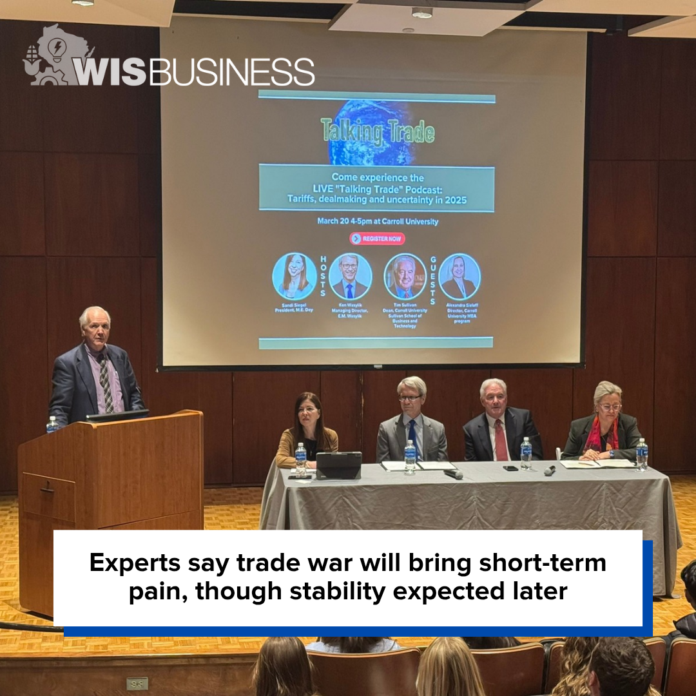Amid the chaos posed by the ongoing trade war, experts say short-term pain is inevitable but they expect global trade will stabilize as the conflict plays out.
Speaking yesterday during a “Talking Trade” podcast event at Carroll University in Waukesha, panelists explored impacts of the tariffs recently enacted under the Trump administration. They also talked about retaliatory moves by targeted countries — both friends and foes alike.
Tim Sullivan, dean of the university’s Sullivan School of Business and Technology, said “the business community is not happy” with the current uncertainty caused by Trump’s “unconventional and dramatic” approach to trade negotiations.
“We like certainty, we like to plan,” said Sullivan, who used to run Bucyrus. “If you’re a public company, you’ve got to come out quarterly and tell your shareholders how you’re going to perform, not only for this quarter but for the year … Trump is playing the long game. And the long game, though, is finite. He’s got four years.”
Sullivan expressed confidence that the international trade situation will likely settle down within six months or a year. He said he has faith in the administration’s plan given the “horrible” national debt problem and trade imbalances with other countries Trump is seeking to address.
“The investment community, you know, they’re starting to relax a little bit, and they need to relax a lot more,” he said. “Things will be fine.”
Still, the ripple effects of the U.S. tariffs and responses by other nations are certain to have impacts, panelists said, including higher domestic prices in some cases.
Ken Wasylik, managing director of international business firm E.M. Wasylik Associates, said “nobody really thought” close U.S. trade allies Mexico and Canada would be hit with such severe tariffs, and trade relationships with other countries are far from settled.
“Our exporters that are selling to Europe are very nervous, because they’re expecting some really tough countervailing tariffs from the European Union and some of the other countries … They’re being very guarded, they’re telling their customers buy now, don’t wait,” he said. “Because if it actually comes through, prices are going to be up 20 percent, 25 percent.”
Sandi Siegel, president of Milwaukee customs broker M.E. Dey, noted an upcoming April 2 deadline for possible reciprocal U.S. tariffs that could be imposed on other nations based on trade imbalances and tariff rates. She said this marks an effort to level the playing field, but noted the administration’s messaging references the possibility of striking a deal in advance to avoid further tariffs.
“When [tariffs] first went in 2019, nobody thought they were going to stick, including me,” she said, adding in some cases businesses negotiated lower prices with vendors in China. “So China did absorb some of it. And then as [tariffs] stuck, as you will, over the four, five years, they started looking for other places to manufacture, like Vietnam.”
Similarly, adjustments are now being made to other countries’ approaches to international commerce, according to Alexandra Sielaff, director of Carroll University’s MBA program. She pointed to Canada possibly reevaluating a contract to buy dozens of F-35 combat aircraft from the United States as an example.
“And so you see rapid movement to readjust the supply chain based on new relationships,” she said.
Sielaff also noted recent changes in Canada’s oil and gas policies, as the country is now looking to sell liquified natural gas to Asian nations in a reversal from its earlier stance.
“You see a lot of nervous tension among Canadians about where it’s all going, so it is a fluid situation,” she said.
Sullivan used the analogy of industry moving like water, finding new paths when faced with obstacles. Sielaff agreed with the comparison.
“I think the initial bump is going to be painful, and like water, folks are going to be seeking new markets where they can get the best price,” she said.
Ultimately, businesses’ bottom lines will drive their purchasing and exporting decisions, regardless of efforts by heads of state to effect change on the global stage, panelists said.
“Even now, with 45% on China, I have some customers telling me it’s still cheaper than trying to source it here in the U.S.,” Siegel said. “That’s the reality.”
Find earlier episodes of “Talking Trade” here, co-hosted by Wasylik and Siegel.






